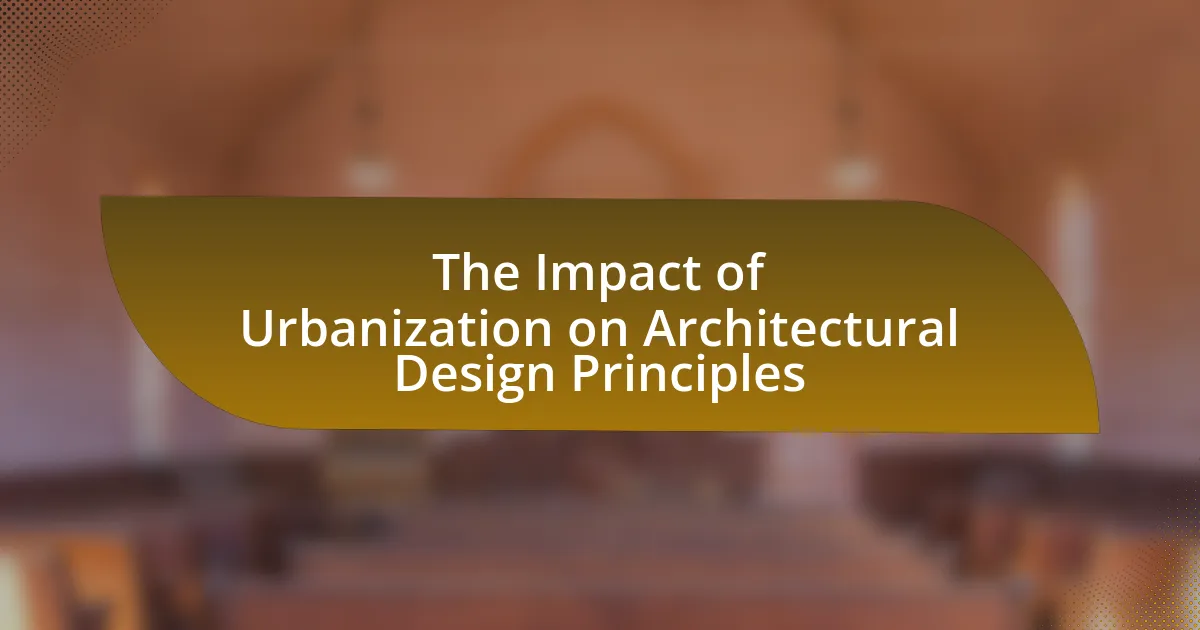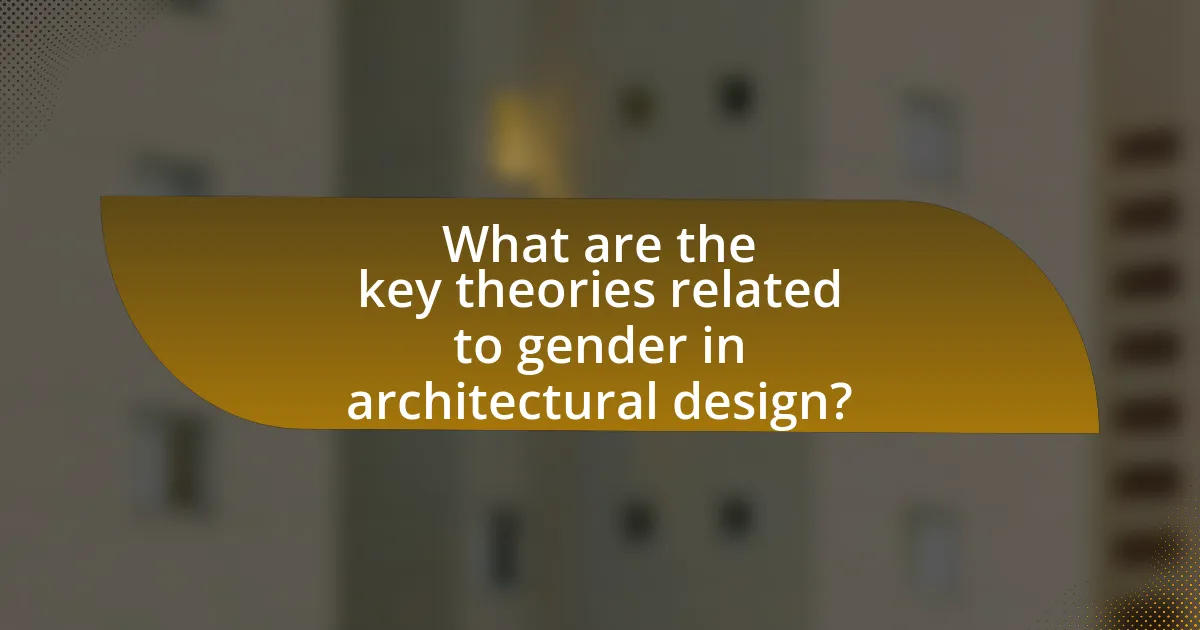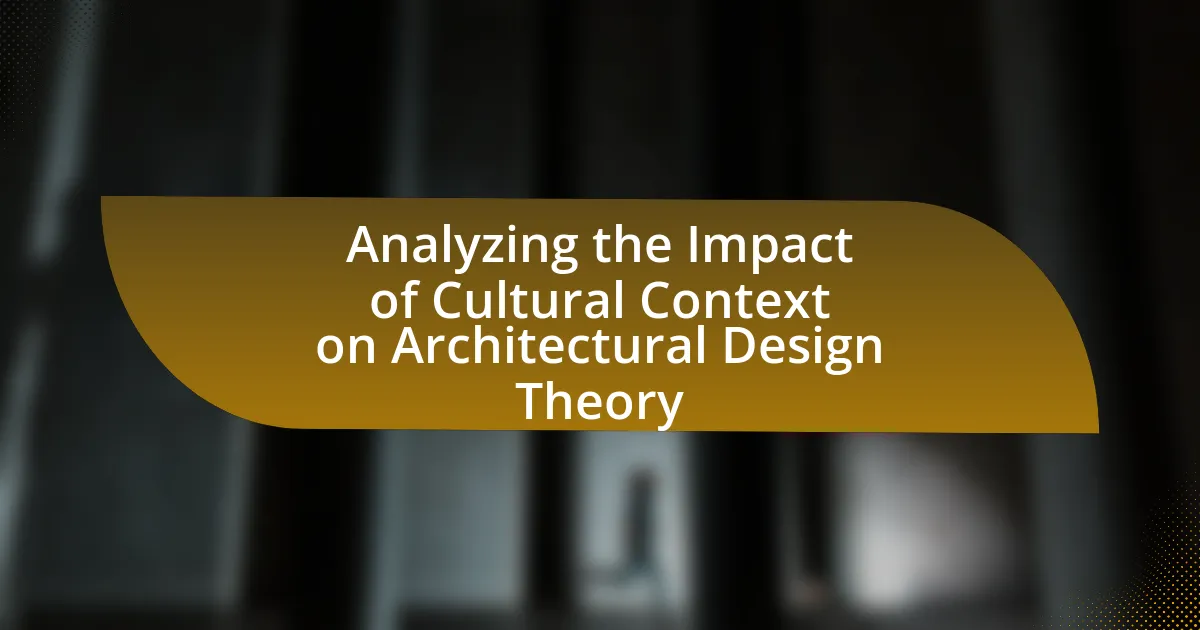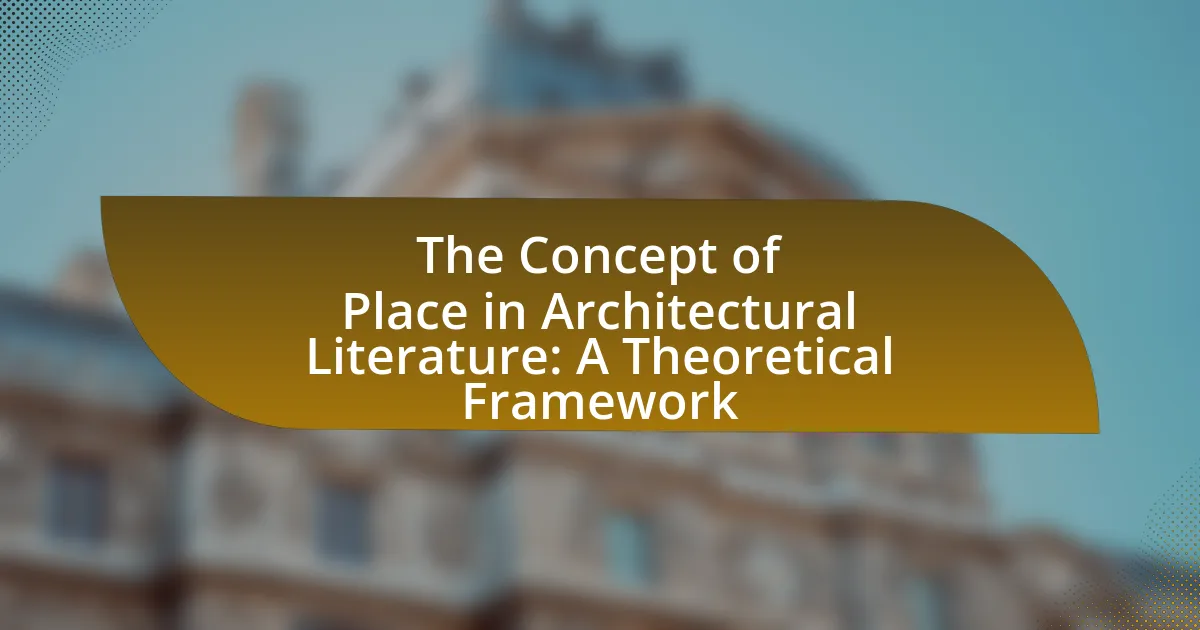Urbanization significantly impacts architectural design principles by necessitating adaptations to accommodate higher population densities and diverse urban functions. Key characteristics of urban architecture include density, mixed-use developments, sustainability, and integration with public spaces. Architects face challenges such as limited space and the need for sustainable design, driving innovation in building practices and technologies. The article explores how urbanization influences architectural choices, community engagement, and the incorporation of smart city concepts, while emphasizing the importance of adaptive reuse and sustainable practices in future urban architecture.

What is the impact of urbanization on architectural design principles?
Urbanization significantly influences architectural design principles by necessitating the adaptation of structures to accommodate higher population densities and diverse urban functions. As cities expand, architects prioritize efficient land use, integrating mixed-use developments that combine residential, commercial, and recreational spaces to foster community interaction. This shift is evidenced by the rise of vertical living solutions, such as high-rise buildings, which maximize space in urban environments. Furthermore, urbanization drives the incorporation of sustainable design practices, as seen in the increasing use of green roofs and energy-efficient materials, aimed at reducing the environmental impact of urban growth. The World Bank reports that urban areas are responsible for over 70% of global carbon emissions, highlighting the urgent need for architects to design with sustainability in mind. Thus, urbanization reshapes architectural principles by emphasizing density, multifunctionality, and sustainability.
How does urbanization influence the overall architectural landscape?
Urbanization significantly influences the overall architectural landscape by driving the demand for higher density, mixed-use developments and innovative design solutions. As populations migrate to urban areas, architects respond by creating structures that maximize space efficiency and integrate residential, commercial, and recreational functions. For instance, cities like Tokyo and New York showcase vertical living through skyscrapers and multi-use complexes, reflecting the need for space in densely populated environments. Additionally, urbanization prompts the incorporation of sustainable practices in architecture, as seen in green buildings that utilize eco-friendly materials and energy-efficient technologies, addressing both environmental concerns and urban living challenges.
What are the key characteristics of architecture in urbanized areas?
The key characteristics of architecture in urbanized areas include density, mixed-use development, sustainability, and integration with public spaces. Urbanized architecture often features high-density structures to accommodate growing populations, exemplified by skyscrapers and multi-family housing. Mixed-use development combines residential, commercial, and recreational spaces, promoting walkability and reducing reliance on transportation. Sustainability is emphasized through energy-efficient designs and the use of green materials, reflecting the need for environmentally responsible practices in densely populated settings. Additionally, urban architecture integrates public spaces, such as parks and plazas, fostering community interaction and enhancing the urban experience. These characteristics collectively address the challenges posed by urbanization, ensuring functional and livable environments.
How does urban density affect architectural design choices?
Urban density significantly influences architectural design choices by necessitating efficient use of space and resources. In densely populated areas, architects often prioritize vertical construction, such as high-rise buildings, to maximize usable floor area while minimizing land consumption. This approach is supported by urban planning principles that advocate for mixed-use developments, which combine residential, commercial, and recreational spaces to enhance accessibility and community interaction. For instance, cities like New York and Tokyo exemplify how high urban density leads to innovative designs that incorporate multifunctional spaces, optimizing land use and promoting sustainability.
What challenges do architects face due to urbanization?
Architects face several challenges due to urbanization, including increased population density, limited space, and the need for sustainable design. Increased population density leads to a higher demand for housing and infrastructure, which can strain resources and complicate planning. Limited space in urban areas restricts design options and necessitates innovative solutions to maximize functionality within smaller footprints. Additionally, the need for sustainable design requires architects to incorporate eco-friendly materials and energy-efficient systems, often complicating traditional design processes. These challenges necessitate a balance between aesthetic appeal, functionality, and environmental responsibility in urban architectural projects.
How do environmental concerns shape architectural design in urban settings?
Environmental concerns significantly influence architectural design in urban settings by promoting sustainable practices and materials. Architects increasingly prioritize energy efficiency, water conservation, and the use of renewable resources to minimize the ecological footprint of buildings. For instance, the integration of green roofs and solar panels in urban architecture not only enhances energy efficiency but also contributes to urban biodiversity and reduces heat island effects. According to the U.S. Green Building Council, buildings that meet LEED certification standards can reduce energy consumption by 30% to 50%, demonstrating the tangible benefits of environmentally conscious design. Additionally, urban planning increasingly incorporates green spaces and natural elements to improve air quality and enhance residents’ well-being, reflecting a holistic approach to environmental sustainability in architecture.
What role does cultural diversity play in urban architectural design?
Cultural diversity significantly influences urban architectural design by fostering a variety of styles, materials, and spatial arrangements that reflect the identities and values of different communities. This diversity leads to the creation of inclusive spaces that cater to the needs of various cultural groups, enhancing social cohesion and community engagement. For instance, cities like Toronto and London showcase architectural elements from multiple cultures, which not only enrich the urban landscape but also promote cultural exchange and understanding. Research indicates that culturally diverse environments can improve residents’ quality of life by providing spaces that resonate with their cultural heritage, as seen in studies conducted by the American Planning Association, which highlight the positive impacts of culturally responsive design on community well-being.
How does urbanization drive innovation in architectural design?
Urbanization drives innovation in architectural design by creating a demand for efficient, sustainable, and adaptable structures that address the challenges of densely populated areas. As cities expand, architects are compelled to develop designs that maximize space utilization, integrate green technologies, and enhance urban livability. For instance, the rise of smart cities has led to the incorporation of advanced technologies in building designs, such as energy-efficient systems and smart materials, which respond to environmental changes. Additionally, urbanization often necessitates the repurposing of existing structures, prompting innovative approaches to adaptive reuse that preserve historical elements while meeting modern needs. This trend is supported by studies indicating that urban areas are increasingly prioritizing sustainable practices, with a report from the United Nations highlighting that 55% of the world’s population now lives in urban settings, emphasizing the urgent need for innovative architectural solutions.
What technological advancements are influenced by urban architectural needs?
Technological advancements influenced by urban architectural needs include smart building technologies, sustainable construction materials, and urban mobility solutions. Smart building technologies, such as IoT sensors and automated systems, enhance energy efficiency and occupant comfort in densely populated areas. Sustainable construction materials, like recycled composites and energy-efficient insulation, address environmental concerns and reduce the carbon footprint of urban structures. Urban mobility solutions, including electric vehicle infrastructure and smart traffic management systems, facilitate efficient transportation in growing cities. These advancements are driven by the necessity to optimize space, improve sustainability, and enhance the quality of life in urban environments.
How do sustainable practices emerge from urbanization trends?
Sustainable practices emerge from urbanization trends through the necessity to address environmental challenges posed by increased population density and resource consumption in urban areas. As cities expand, the demand for efficient resource management, reduced carbon footprints, and improved quality of life drives the adoption of sustainable design principles. For instance, the implementation of green building standards, such as LEED certification, has become prevalent in urban developments, promoting energy efficiency and sustainable materials. Additionally, urbanization has led to the integration of public transportation systems, which reduces reliance on personal vehicles and lowers greenhouse gas emissions. According to the United Nations, urban areas are responsible for approximately 70% of global CO2 emissions, highlighting the urgent need for sustainable practices to mitigate climate change impacts.
What are the implications of urbanization on community spaces?
Urbanization significantly alters community spaces by increasing population density, which often leads to the reduction of green areas and public spaces. As cities expand, the demand for housing and infrastructure typically prioritizes development over the preservation of communal areas, resulting in less accessible parks and recreational facilities. For instance, a study by the United Nations in 2018 indicated that urban areas are expected to house 68% of the global population by 2050, intensifying the competition for land use. This shift can diminish social interactions and community cohesion, as residents may have fewer opportunities to engage in shared public spaces. Additionally, urbanization can lead to gentrification, which displaces long-standing communities and alters the cultural fabric of neighborhoods, further impacting the availability and nature of community spaces.
How does urbanization affect public spaces and their design?
Urbanization significantly transforms public spaces and their design by increasing population density and altering land use patterns. As cities expand, the demand for accessible and multifunctional public spaces rises, leading to designs that prioritize efficiency, sustainability, and community engagement. For instance, urban areas often incorporate green spaces, pedestrian pathways, and mixed-use developments to accommodate diverse activities and promote social interaction. Research indicates that well-designed public spaces can enhance urban livability, with studies showing that access to parks and recreational areas improves mental health and community cohesion.
What strategies can architects use to enhance community engagement in urban areas?
Architects can enhance community engagement in urban areas by implementing participatory design processes that involve local residents in decision-making. This approach fosters a sense of ownership and ensures that the built environment reflects the community’s needs and values. For instance, studies have shown that projects incorporating community feedback, such as the participatory budgeting initiative in Porto Alegre, Brazil, lead to higher satisfaction and better alignment with local priorities. Additionally, architects can utilize interactive workshops and design charrettes to gather input, allowing community members to express their ideas and preferences directly. This strategy not only improves the relevance of architectural solutions but also strengthens community ties and promotes social cohesion.
How can architects adapt to the challenges posed by urbanization?
Architects can adapt to the challenges posed by urbanization by integrating sustainable design practices, utilizing advanced technologies, and prioritizing community engagement. Sustainable design practices, such as green building materials and energy-efficient systems, help reduce environmental impact and enhance livability in densely populated areas. Advanced technologies, including Building Information Modeling (BIM) and smart city solutions, enable architects to optimize space and resources effectively. Furthermore, prioritizing community engagement ensures that architectural designs meet the needs of local populations, fostering social cohesion and enhancing urban resilience. These strategies are essential as urbanization continues to increase, with the United Nations projecting that 68% of the world’s population will live in urban areas by 2050.
What best practices should architects follow in urban design?
Architects should prioritize sustainability, community engagement, and adaptability in urban design. Sustainability involves using eco-friendly materials and energy-efficient systems to minimize environmental impact, as evidenced by the increasing adoption of green building certifications like LEED, which promote sustainable practices. Community engagement ensures that the needs and preferences of local residents are considered, fostering a sense of ownership and belonging; studies show that projects involving community input are more successful and better received. Adaptability refers to designing spaces that can evolve with changing urban dynamics, which is crucial in rapidly urbanizing areas where demographics and needs shift frequently. These best practices collectively enhance the livability and resilience of urban environments.
How can collaboration with urban planners improve architectural outcomes?
Collaboration with urban planners can significantly enhance architectural outcomes by ensuring that designs are contextually relevant and aligned with broader urban development goals. This partnership allows architects to integrate zoning regulations, infrastructure planning, and community needs into their designs, resulting in buildings that are not only aesthetically pleasing but also functional and sustainable. For instance, studies have shown that projects developed through collaborative efforts, such as the High Line in New York City, have led to increased property values and improved community engagement, demonstrating the tangible benefits of such cooperation.
What future trends in architectural design are emerging from urbanization?
Future trends in architectural design emerging from urbanization include increased emphasis on sustainability, mixed-use developments, and smart city integration. As urban populations grow, architects are prioritizing eco-friendly materials and energy-efficient designs to reduce environmental impact. For instance, the World Green Building Council reports that green buildings can reduce energy consumption by up to 50%. Additionally, mixed-use developments are becoming more prevalent, allowing for residential, commercial, and recreational spaces to coexist, which enhances community interaction and reduces transportation needs. Furthermore, the integration of smart technologies in urban architecture is on the rise, with cities implementing IoT solutions to improve infrastructure efficiency and enhance the quality of urban life. This trend is supported by research from the McKinsey Global Institute, which highlights that smart city technologies can improve urban living conditions and operational efficiency.
How will smart city concepts influence architectural design principles?
Smart city concepts will significantly influence architectural design principles by integrating technology and sustainability into urban environments. These concepts promote the use of smart infrastructure, which necessitates designs that accommodate advanced technologies such as IoT devices, energy-efficient systems, and data analytics. For instance, buildings will increasingly incorporate smart materials that adapt to environmental conditions, enhancing energy efficiency and occupant comfort. Additionally, urban planning will prioritize mixed-use developments that foster community interaction and reduce reliance on transportation, aligning with sustainable practices. Research indicates that cities implementing smart technologies can reduce energy consumption by up to 30%, demonstrating the tangible benefits of these architectural adaptations.
What role will adaptive reuse play in future urban architecture?
Adaptive reuse will play a critical role in future urban architecture by promoting sustainability and preserving cultural heritage. As urban areas face increasing population density and environmental challenges, adaptive reuse allows for the transformation of existing structures into functional spaces, reducing the need for new construction and minimizing waste. According to a study by the National Trust for Historic Preservation, adaptive reuse projects can reduce carbon emissions by up to 80% compared to new builds, highlighting its environmental benefits. Additionally, this approach fosters community identity by retaining historical elements, which can enhance social cohesion and economic vitality in urban settings.
What practical tips can architects implement to address urbanization challenges?
Architects can implement mixed-use developments to address urbanization challenges effectively. By designing spaces that combine residential, commercial, and recreational facilities, architects can reduce the need for transportation, thereby minimizing traffic congestion and promoting walkability. Research indicates that mixed-use developments can lead to a 20-30% reduction in vehicle trips, enhancing community interaction and sustainability. Additionally, architects should prioritize green building practices, such as incorporating energy-efficient materials and renewable energy sources, which can significantly lower the environmental impact of urban structures. Studies show that buildings designed with sustainability in mind can reduce energy consumption by up to 50%. Finally, engaging with local communities during the design process ensures that the architectural solutions meet the specific needs of the population, fostering a sense of ownership and improving the overall quality of urban life.




























